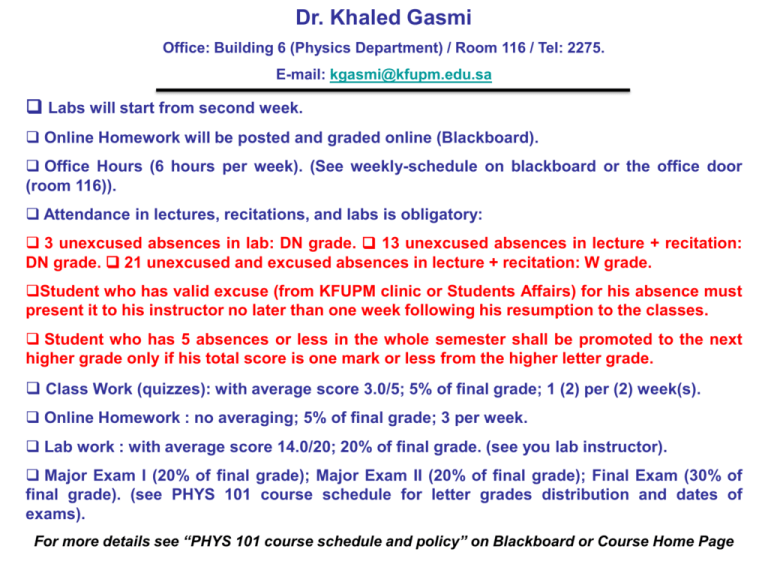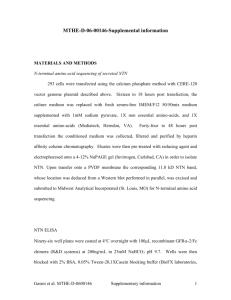Chapter 1
advertisement

Dr. Khaled Gasmi Office: Building 6 (Physics Department) / Room 116 / Tel: 2275. E-mail: kgasmi@kfupm.edu.sa Labs will start from second week. Online Homework will be posted and graded online (Blackboard). Office Hours (6 hours per week). (See weekly-schedule on blackboard or the office door (room 116)). Attendance in lectures, recitations, and labs is obligatory: 3 unexcused absences in lab: DN grade. 13 unexcused absences in lecture + recitation: DN grade. 21 unexcused and excused absences in lecture + recitation: W grade. Student who has valid excuse (from KFUPM clinic or Students Affairs) for his absence must present it to his instructor no later than one week following his resumption to the classes. Student who has 5 absences or less in the whole semester shall be promoted to the next higher grade only if his total score is one mark or less from the higher letter grade. Class Work (quizzes): with average score 3.0/5; 5% of final grade; 1 (2) per (2) week(s). Online Homework : no averaging; 5% of final grade; 3 per week. Lab work : with average score 14.0/20; 20% of final grade. (see you lab instructor). Major Exam I (20% of final grade); Major Exam II (20% of final grade); Final Exam (30% of final grade). (see PHYS 101 course schedule for letter grades distribution and dates of exams). For more details see “PHYS 101 course schedule and policy” on Blackboard or Course Home Page Chapter 1. Measurement 1.1. Measurement of a Physical Parameter 1.2. The International System of Units 1.3. Changing Units 1.4. Basic Units in Mechanics 1.5. Significant Figures 1.6. Dimensional Analysis Dr. K. Gasmi (Physics 101 – Lecture) (1-1) Chapter 1: Measurement 1.1 Measurement of a Physical Parameter In physics we perform experiments in which we measure one or many “physical parameters” or “physical quantities”. We try to deduce the relationship between these physical parameters in the form of a mathematical equation, which we call the “physical law”. The physical law describe the “phenomena” under study. A familiar example is the “period of oscillation of a simple pendulum”. The experiment in this case consists of measuring the time “T” needed by the pendulum of length “L” when it is moved away from its equilibrium position to make one oscillation. Dr. K. Gasmi (Physics 101 – Lecture) (1-2) Chapter 1: Measurement 1.1 Measurement of a Physical Parameter If we plot T versus square root of L we get a straight line. This is expressed in the form: L g T (periode of oscillation) T 2 g is known as “Earth gravitational constant” at sea level, and equals 9.8 m/s2 L1/2 (Length) Dr. K. Gasmi (Physics 101 – Lecture) (1-3) Chapter 1: Measurement 1.2 The International System of Units, S.I. For every physical parameter we need an appropriate “unit”, i.e. a standard (or reference) by which we perform the measurement. We need to define only the units of the “basic physical parameters”. In “Mechanics” these basic parameters are “Length”, “Time”, and “Mass”. As an agreement (convention), we define the units in the “International System of Units (S.I.)”. In the International System of Units (S.I.), the units of the basic physical parameters in mechanics are: Parameter Unit Symbol Length meter (m) Time second (s) Mass kilogram (kg) Dr. K. Gasmi (Physics 101 – Lecture) (1-4) Chapter 1: Measurement 1.3 Changing Units Quite often we have to change the units of a physical parameter. To do that we must have the conversion factor between the different system of units or within the same system of units (Prefixes). Example: 1 mile = 1609 m / 1m = 1000 mm Note: Appendix D in the text book lists several conversion factors between (S.I.) units and other systems. Example 1: Express the highway speed limit of 65 miles per hour in meters per second? The conversion factors that we will use: 1 mile = 1609 m / 1 hour = 3600 s Solution: The highway speed limit in (S.I.) units is 29 m/s Dr. K. Gasmi (Physics 101 – Lecture) (1-5) Chapter 1: Measurement 1.4 Basic Units in Mechanics The Meter: The Standard of Length The meter (m) is defined in the international system of units (SI) as the distance traveled by light in vacuum during the time interval of 1/299792458 (1/3E+8) of a second. Dr. K. Gasmi (Physics 101 – Lecture) (1-6) Chapter 1: Measurement 1.4 Basic Units in Mechanics The Second: The Standard of Time The second (s) is defined in the international system of units (SI) as the duration of 9192631770 (9E+9) oscillations of the light radiation corresponding to the transition between the two hyperfine levels of the ground state of the cesium atom 133Cs. This definition is so precise that it would take two cesium clocks 6000 years before their readings would differ by more than 1 second. Dr. K. Gasmi (Physics 101 – Lecture) (1-7) Chapter 1: Measurement 1.4 Basic Units in Mechanics The Kilogram: The Standard of Mass The kilogram (kg) is defined in the international system of units (SI) as the mass of a platinum-iridium cylinder (shown in the figure below) preserved at the International Bureau of Weights and Measures near Paris and assigned a mass of 1 kilogram. Accurate copies have been sent to other countries. Dr. K. Gasmi (Physics 101 – Lecture) (1-8) Chapter 1: Measurement 1.5 Significant Figures A physical parameter can be determined with a variable degree of “accuracy” (precision) depending on the measurement method and/or the measuring instrument. Example 2: If we measure the length L of an object with a ruler (accuracy of 1 mm or smallest division), we can write L as: L = 1.234 m. The length L is given with four significant figures. It would be irrelevant to write L as: L = 1.2345 m because the ruler cannot measure a fraction of a millimeter. In the other hand if we use a caliper (accuracy of 0.1mm), we can write L as: L = 1.2345 m. The length L is given with five significant figures. Dr. K. Gasmi (Physics 101 – Lecture) (1-9) Chapter 1: Measurement 1.5 Significant Figures Ruler (accuracy of 1mm) Caliper (accuracy of 0.01 mm) Dr. K. Gasmi (Physics 101 – Lecture) (1-10) Chapter 1: Measurement 1.5 Significant Figures The accuracy of a measurement is the degree of closeness of measurement of a quantity to that quantity’s true value. The precision of a measurement is the degree to which repeated measurements under unchanged conditions show the same results. Is the number of relevant reports identified divided by the total number of reports identified. The sensitivity is the number of relevant reports identified divided by the total number of relevant reports in existence. (1-11) Chapter 1: Measurement 1.5 Significant Figures Example 3: a car traveling with constant speed v covers a distance d = 123 m in a time t = 7.89 s. The speed v is given by: v = d / t = 123 m / 7.89 s = 15.5893536 m/s (using calculator). The correct way to express v is: v = 15.6 m/s, with only three significant figures. It is insignificant to use nine significant figures to express v because d and t used to determine v are known with an accuracy of only three significant figures. Dr. K. Gasmi (Physics 101 – Lecture) (1-12) Chapter 1: Measurement 1.5 Significant Figures Important Note: In a calculation the number of significant figures cannot be lager than the number of significant figures of the parameters used in the calculation Dr. K. Gasmi (Physics 101 – Lecture) ! (1-13) Chapter 1: Measurement 1.5 Significant Figures Rules used for deciding the number of significant figures in a measured quantity: (1) All nonzero digits are significant: 1.234 g has 4 significant figures. 1.2 g has 2 significant figures. (2) Zeroes between nonzero digits are significant: 1002 kg has 4 significant figures. 3.07 ml has 3 significant figures. (3) Leading zeros to the left of the first nonzero digits are not significant; such zeroes just indicate the position of the decimal point: 0.001 C has only 1 significant figure. 0.012 g has 2 significant figures. Dr. K. Gasmi (Physics 101 – Lecture) (1-14) Chapter 1: Measurement 1.5 Significant Figures Rules used for deciding the number of significant figures in a measured quantity: (4) Trailing zeroes that are to the right of a decimal point in a number are significant: 0.0230 ml has 3 significant figures. 0.20 g has 2 significant figures. (5) When a number ends in zeroes that are not to the right of a decimal point, the zeroes are not significant: 190 miles has 2 significant figures 1.90 × 102 miles (3 significant figures). 1.9 × 102 miles (2 significant figures). 2 × 102 miles (1 significant figures). Dr. K. Gasmi (Physics 101 – Lecture) (1-15) Chapter 1: Measurement 1.5 Significant Figures Rules for mathematical operations: In carrying out calculations, the general rule is that the accuracy of a calculated result is limited by the least accurate measurement involved in the calculation. When multiplying or dividing, the number of significant figures in the product or quotient should be no greater than the number of significant figures in the least precise of the factors. 3.0 (2 significant figures ) × 12.60 (4 significant figures) = 37.8000 which should be rounded off to 38 (2 significant figures). Dr. K. Gasmi (Physics 101 – Lecture) (1-16) Chapter 1: Measurement 1.5 Significant Figures Rules for mathematical operations: In adding or subtracting, the least significant digit of the sum or difference occupies the same relative position as the least significant digit of the quantities being added or subtracted. In this case the number of significant figures is not important; it is the position that matters! 103.9 (1 decimal place) + 2.10 (2 decimal places) + 0.319 (3 decimal places) = 106.319, which should be rounded to 106.3 (1 decimal place). Dr. K. Gasmi (Physics 101 – Lecture) (1-17) Chapter 1: Measurement 1.5 Significant Figures Significant figures 37.76 + 3.907 + 226.4 = 268.1 319.15 – 32.614 = 286.54 104.630 + 27.08362 + 0.61 = 1.3 x 10^2 125 – 0.23 + 4.109 = 1.30 x 10^2 2.02 x 2.5 = 5.0 600.0 / 5.2302 = 114.7 0.0032 x 273 = 0.87 (5.5)^3 = 1.7 x 10^2 45 x 3.00 = 1.4 x 10^2 Chapter 1: Measurement 1.6 Dimensional Analysis In physics, dimensional analysis is a tool to check physical laws by using the dimensions of their physical parameters. The dimension of a physical parameter is the combination of the basic physical parameters (in mechanics, length, time, and mass). Example 4: The physical parameter Speed has the dimension length by unit time. Important Note: Any equation must have the same dimensions in the left and right sides. Checking this is the basic way of performing dimensional analysis Dr. K. Gasmi (Physics 101 – Lecture) ! (1-18)




